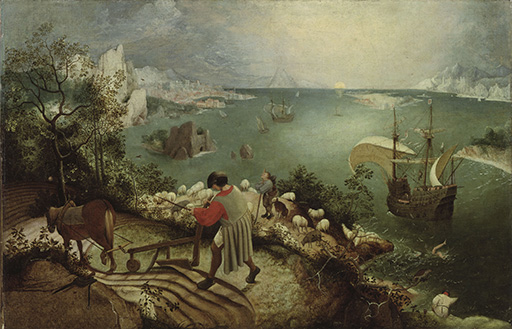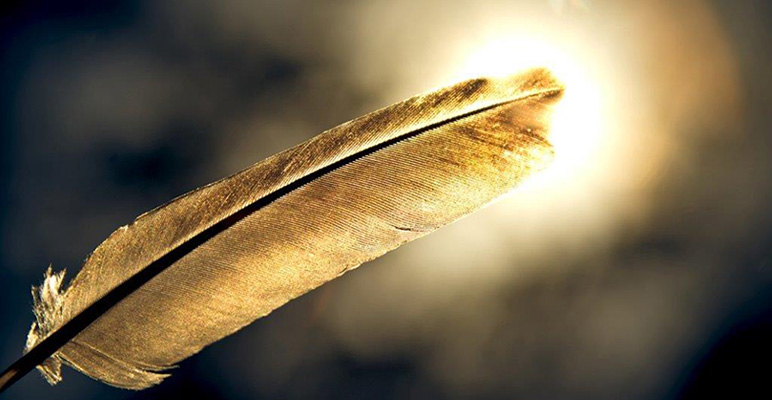4.1 Brueghel’s Landscape with the Fall of Icarus
The following activity focuses on Brueghel’s Landscape with the Fall of Icarus, and encourages you to think about how this artistic version of the myth relates to Ovid’s narrative.
Activity 4
Look at Brueghel’s Landscape with the Fall of Icarus.

- Does your knowledge of the Ovidian narrative affect your response to the painting?
- How would you describe its content if you were not familiar with the myth of Icarus?
Discussion
You may have been struck by the difficulty of finding Icarus in the scene – even if we could stand in front of this large canvas, the white legs disappearing into the water are hardly central. This is a busy but not a bustling landscape and there is a distinct sense of measured movement in the human activities Brueghel portrays. The influence of the bright Mediterranean dawn is very much in evidence in the scene but possibly the ploughman sports the richer hues of the Northern school of painting. You may agree that the viewer is drawn into the picture and invited not only to examine the world beyond this figure in the foreground but also to wonder how each of its parts or vignettes relate to each other. The drowning boy is the only disturbance, a sudden and uncalculated event occurring in an otherwise (at first glance) tranquil setting.
Icarus is so close to the ship (this delicate craft is like almost everything in the picture, animate and inanimate alike, uncaring of the tragic death of the boy in the water) that if the viewer of the painting did not know the myth it would be reasonable to assume that Icarus was a man or sailor overboard. In that case the wonder of a boy falling from the sky has been transformed into a blip or a blot on the landscape.
In Peter Wagner’s Icons, Texts, Iconotexts there is yet another interpretation of Brueghel’s almost mischievous depiction of Icarus. The somersaulting boy could be a swimmer happily disporting himself in contrast to the ploughman who is toiling away – the sort of sardonic comment Brueghel was fully capable of making about contrasts between the labouring peasantry and their wealthy ‘betters’ (Wagner, 1996, p. 276).
If you look Icarus up online, or in a mythological dictionary, you may find another version of the story, one in which Icarus followed his father from Athens by boat and was shipwrecked off Samos. There was also a tradition that Daedalus and Icarus sailed from Crete. So Brueghel may be following Ovid for the scene but suggesting a less miraculous method of escape for the exiles.
Ovid’s tragic tale is very much marginalised (after all, the painting is called Landscape with the Fall of Icarus). Nor is there any sign of Daedalus. It was long thought that Daedalus had originally been included on the canvas, as it looked as if a high aerial figure had been subsequently painted over or painted out. The amazed spectators of the poem mind their own business in Brueghel.
We might wonder what the point was of including Icarus at all. A simple answer would be that biblical and classical scenes were regarded as worthier subject matter for high art than a mere landscape. In theory the presence of Icarus elevates the genre Brueghel has chosen. In other paintings Brueghel marginalises momentous religious events in a similar way, focusing on environment and setting rather than the alleged subjects, such as the martyrdom of Christ or the journey of the Magi.
However, there is clearly a more complex agenda at work in all Brueghel’s paintings and his relationship to Ovid’s text is a subtle and subversive one. On closer inspection the partridge (Perdix) is in the picture (bottom right and on the branch above the angler preoccupied with his fishing) which demonstrates that Brueghel is consciously engaging with Ovid’s narrative. The presence of the partridge reminds a viewer familiar with Ovid that Perdix was enjoying his moment of revenge. To complicate matters there is a counter-view that the partridge is not in fact looking towards Icarus but is as detached or unobservant as the other spectators.
In that case you may feel that the painting is pure parody and very far from the poignancy of Ovid’s narrative. No one in it is noticeably concerned at the tragedy and the legs are positively comical. Brueghel certainly seems to be altering Ovid in his portrayal of the ‘witnesses’ to this incredible sight, men flying like gods. Only the shepherd is looking upwards and this is, in any case, a conventional way of portraying shepherds in art. As for the ploughman who clearly supplants Icarus as the painting’s protagonist (and it is characteristic of Brueghel to promote everyday rural activities in this way), he bears out the German proverb that ‘a farmer does not leave his plough for the sake of a dying man’. And if you look carefully, there is a skull halfway up the trunk of the fruit tree towards which the plough furrows run.
